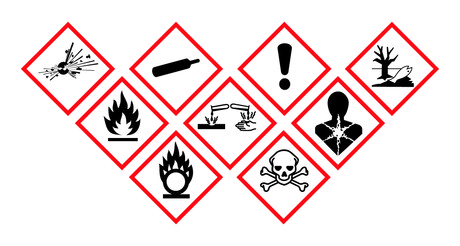Are you ready for GHS?

The Globally Harmonized System of Classification and Labelling of Chemicals (GHS), as its name implies, is a system used globally to classify and communicate chemical hazards, using specified terms and information on chemical labels and Safety Data Sheets (SDS), which are internationally recognised and consistent.
GHS will be mandatory in Australia from 01 January 2017, in all jurisdictions where the Model Work Health and Safety (WHS) Regulations have been adopted. The GHS was introduced in Australia in January 2012, with a 5-year transition period, in order to give chemical manufacturers and importers enough time to implement all the necessary changes. GHS applies to chemicals with physical hazards (eg, flammable liquids), health hazards (eg, carcinogens) and environmental hazards (eg, aquatic toxicity).
In Australia, the GHS is supported by:
- the model Code of Practice for Labelling of Workplace Hazardous Chemicals, and
- the model Code of Practice for the Preparation of Safety Data Sheets for Hazardous Chemicals.
Safe Work Australia maintains the Hazardous Chemical Information System (HCIS) database. This is a list of over 4500 hazardous chemicals, classified in accordance with the GHS. The HCIS has a search function for labelling information and workplace exposure standards.
Hazardous Chemical Information System
The GHS uses pictograms, signal words and hazard and precautionary statements to communicate information. There are nine hazard pictograms in the GHS which represent the physical, health and environmental hazards. These are named: Explosives, Flammables, Oxidisers, Gasses under pressure, Corrosives, Acute toxicity, Environmental hazard, Harmful/irritant Harmful to ozone layer and Severe health hazards.
Pictogram poster for classification and labelling
The words ‘Danger’ and ‘Warning’ are used in the GHS as signal words to indicate the severity of a hazard. ‘Danger’ is used for the more severe or a significant hazard, while ‘Warning’ is used for the less severe hazards.
The Model Work Health and Safety laws require that all manufacturers and importers of chemicals determine if a chemical is hazardous and to classify the chemical according to the GHS. Manufacturers and importers must also ensure that correct GHS labels and Safety Data Sheets (SDS) are prepared for hazardous chemicals. The SDS is a document that provides information on the properties of hazardous chemicals and their effects on health and safety in the workplace. It must as a minimum include information on the identity, health and physicochemical hazards, safe handling and storage, emergency procedures and disposal considerations of hazardous chemicals and their constituents.
Code of Practice — Preparing SDS
The question has been raised as to whether SDS received from overseas will automatically be adequate for use in Australia? Safe Work Australia reports that the model Work Health and Safety laws require specific information in an SDS that may not be present in an overseas SDS eg, contact details of the Australian manufacturer or importer of the hazardous chemical.
Under the model WHS laws an SDS for a hazardous chemical must:
- use Australian legal units of measurement;
- state the date that the SDS was prepared and the date it was last reviewed;
- state the name and the Australian address and business contact number of the manufacturer or the importer; and
- state an Australian business number from which information about the chemical can be obtained in an emergency, and be in English.
The Australian importer of a hazardous chemical has the responsibility to classify the chemical and prepare the SDS. Even if an SDS has been prepared overseas specifically for Australia, the importer must still ensure that it complies with Australian requirements.
Robot dog can 'sniff' hazardous gases in inaccessible environments
To keep humans out of harm's way, researchers have created a four-legged, dog-like robot that...
Preventing accidents with thermal fluid safety protocols
How can health and safety protocols contribute to a safer and more effective work environment...
Toxic ammonia gas 'sniffed out' by sensor
A small ammonia gas sensor that could enable safer hydrogen storage has been developed by...










